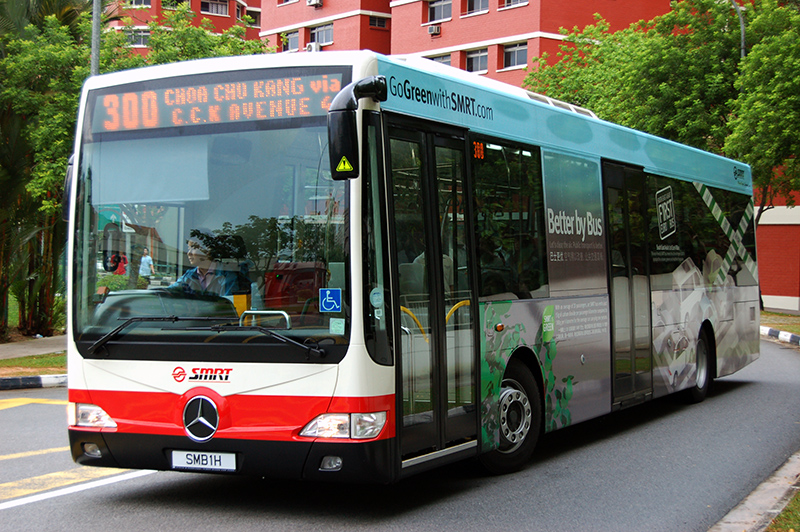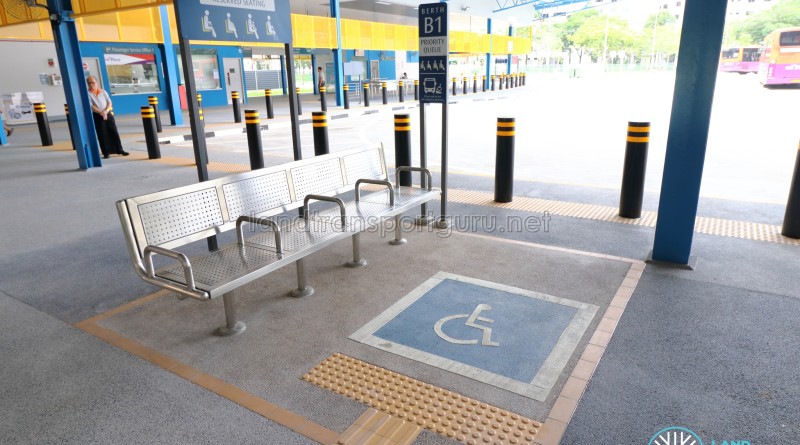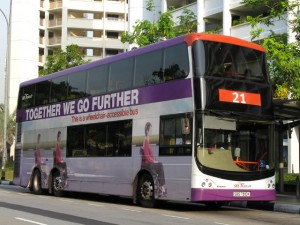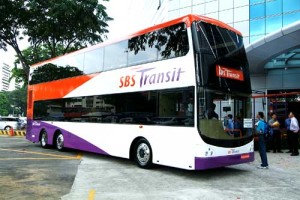Wheelchair Accessible Bus Routes, as the name implies, are bus routes which allow for the carriage of Passengers-in-wheelchair (PIW). Personal mobility aids, such as mobility scooters, are also allowed onboard,
Since 2006, all new public buses in Singapore are wheelchair-accessible. These wheelchair-accessible buses (WABs) typically feature a low-floor or low-entry layout with step-free access at the rear door. A manual wheelchair ramp is installed at the rear door, and up to 2 wheelchair bays would be installed on board. The Bus Captain would assist with ramp deployment and assisting PIWs with boarding/alighting and fare payment.
All public bus services are wheelchair-accessible from 17 October 2019.
History
Wheelchair-accessible buses were first announced on 15 February 2006 when SBS Transit unveiled the Volvo B9TL (CDGE), a prototype low-entry double-decker bus and the first of its kind in Singapore. Built locally by ComfortDelGro Engineering, a total of 150 buses of the type were ordered, and scheduled for assembly by the end of 2006 (this was later increased to 200 buses).
The introduction of wheelchair-accessible bus travel was in partnership with LTA and various welfare organizations. LTA also helped to fund the incremental capital cost of providing manual ramps and associated features (such as the dedicated PIW alighting bell-push, padded backrest, and associated grab poles and stanchion poles), as well as improving bus stop infrastructure to make them more friendly to wheelchair-bound passengers (PIWs).
The first wheelchair-accessible bus service was launched on Monday, 26 June 2006 with the introduction of 10 new Volvo B9TL (CDGE) buses to SBS Transit Service 21 plying between Pasir Ris and St. Michaels. Service 21 was chosen to be the first WAB service after consultation with Voluntary Welfare Organisations (VWOs) and the Land Transport Authority. It runs past the premises of the Handicaps Welfare Association (HWA) in Whampoa, enabling members to gain direct access to major town centres like Pasir Ris, Tampines and Bedok. It also provides connections to Tan Tock Seng Hospital and other medical facilities.
Service 21, after the intake of 10 new WABs, had a fleet size of 23 buses. This ensured that PIWs could board a WAB every one or two buses of waiting. All PIWs were also entitled to free travel until the end of July that year.
In addition to the Volvo B9TL, SBS Transit also ordered 1100 low-entry Scania K230UB buses to replace their ageing buses. The Euro IV batch (501 buses) featured two wheelchair bays, while the later Euro V batch (600 buses) had just one wheelchair bay, with three side-facing seats in place of a second wheelchair bay.
Following up on strong PIW demand, on 30 October 2006, SBS Transit Service 147 became the second WAB to be launched, with 19 new WABs in the fleet of 37 buses, once again ensuring that PIWs could board a WAB every one or two buses of waiting. Two months later, on 3 December 2006, Services 12, 196 and 198 were made wheelchair-accessible services. With more WABs being introduced into SBS Transit’s fleet, such as the Volvo B9TL Wright and Mercedes-Benz Citaro, more WAB services were progressively introduced.

SMRT Buses also introduced wheelchair-accessible buses, with a fleet of low-entry Mercedes-Benz OC500LE buses with bodywork by Gemilang Coachworks entering service in 2008. Like the Volvo B9TL, this low-entry bus also had zero-step entrances but two wheelchair berths instead of one. SMRT introduced its first wave of WAB services on 1 June 2009, with services 171, 172, 189, 307, 811, 851 and 945.
All newer buses acquired by SBS Transit and SMRT Buses since 2006 were wheelchair-accessible.
Wheelchair-accessible buses
Any wheelchair-accessible bus (WAB) was identified with a wheelchair decal on the front windscreen. WABs can be deployed on non-WAB services but were not allowed to ferry PIWs. However, with the increasing proportion of wheelchair-accessible buses on Singapore roads, the wheelchair decal was not made mandatory.
WABs are typically equipped with a manual ramp at the rear exit door. The wheelchair bay is usually located on the right of the bus, opposite the exit door. PIWs are required to rest their wheelchair against a backrest (a horizontal cushion) while the bus is in motion. In addition, some buses provide a seat belt around the backrest. On some bus designs, like SMRT Mercedes-Benz Citaros and the MAN A22, the backrest doubles up as a foldable seat while there are no PIWs onboard. WABs also come with a special bell for PIWs to alert the driver when they intend to alight, though this bell is sometimes misused by other passengers.
Drivers on WAB routes are also trained on how to handle PIWs onboard. For PIW boarding, the driver will stop the bus closer to the kerb, and allow other passengers to alight first, before assisting the PIW onboard. The driver will deploy the manual ramp and ensure that the PIW is secured with the back of the wheelchair leaning on the backrest and wheels in the locked position. Finally, the driver will assist the PIW with fare payment before opening the front door to allow other passengers onboard. Alighting for PIWs works the same way, with the bus driver assisting with the manual ramp deployment.
Bus Stops
Some bus stops are inaccessible to PIWs owing to site conditions; usually when there are steps leading up to the kerb edge or when no footpaths are leading to the bus stop. As of 2016, 137 bus stops were not yet wheelchair-accessible, which represented less than 3% of the 4,700 bus stops in Singapore. The LTA has targeted to upgrade all these bus stops by 2020.
PIWs are also not allowed across the border, and cross-border bus services only allow PIWs along the Singapore sectors.
Timeline:
| Wheelchair-Accessible Bus Service Implementation (Jun 2006 – Oct 2019) |
||
| Date | Bus Services | Operator |
| 26 Jun 2006 | 21 | SBS Transit |
| 30 Oct 2006 | 147 | |
| 3 Dec 2006 | 12, 196, 198 | |
| 22 May 2007 | 2, 51, 72, 76 | |
| 20 Aug 2007 | 7, 80 | |
| 17 Dec 2007 | 143 | |
| 14 Jul 2008 | 14, 123, 174, 185 | |
| 2 Dec 2008 | 64, 130, 183, 199, 232, 268 | |
| 1 Jun 2009 | 171, 172, 189, 307, 811, 851, 945 | SMRT Buses |
| 26 Oct 2009 | 3, 27, 34, 53, 142, 293, 358, 410 | SBS Transit |
| 3 Dec 2009 | 13, 15, 36, 52, 54, 57, 291, 333 | |
| 28 Feb 2010 | 29, 63, 113, 265, 334, 359 | |
| 28 Jun 2010 | 45, 48, 59, 94, 240, 242 | |
| 18 Oct 2010 | 43, 95, 181, 228, 235 | |
| 29 Nov 2010 | 858 | SMRT Buses |
| 2 Dec 2010 | 24, 86, 151, 225, 231, 335 | SBS Transit |
| 7 Mar 2011 | 18, 22, 55, 60, 135, 136, 162, 162M, 241, 261, 269 | |
| 27 Jun 2011 | 5, 17, 38, 39, 99, 194, 354, 400, 402 | |
| 26 Sep 2011 | 19, 100, 109, 133, 138, 154, 156, 315, 317 | |
| 3 Dec 2011 | 16, 30, 87, 101, 131, 175, 272, 273, 275, 282, 284, 285, 292, 403 | |
| 61, 855, 920, 922, 950 | SMRT Buses | |
| 26 Mar 2012 | 10, 25, 58, 66, 69, 105, 165, 168 | SBS Transit |
| 29 Apr 2012 | 187, 852, 857, 970 | SMRT Buses |
| 25 Jun 2012 | 33, 78, 79, 96, 97, 98, 98M, 124, 125, 197, 243G, 243W | SBS Transit |
| 1 Jul 2012 | 75, 77, 177, 700, 700A | SMRT Buses |
| 30 Sep 2012 | 56, 128, 163, 163M, 166, 186, 195, 229, 502, 506 | SBS Transit |
| 15 Nov 2012 | 167, 859, 860, 966, 980, 985 | SMRT Buses |
| 3 Dec 2012 | 32, 70, 70M, 73, 93, 111, 238, 325, 372, 518 | SBS Transit |
| 31 Mar 2013 | 4, 50, 62, 82, 116, 119, 132, 158, 513 | |
| 21 Apr 2013 | 173, 882, 941, 981 | SMRT Buses |
| 9 Jun 2013 | 85, 88, 112, 120, 145, 222 | SBS Transit |
| 7 Jul 2013 | 902, 965, 969 | SMRT Buses |
| 29 Sep 2013 | 178, 853, 904, 947 | |
| 30 Sep 2013 | 20, 141, 157, 182, 182M, 192 | SBS Transit |
| 3 Dec 2013 | 6, 40, 90, 139 | |
| 2 Mar 2014 | 803, 927, 961, 972 | SMRT Buses |
| 23 Mar 2014 | 26, 35, 49, 65, 161 | SBS Transit |
| 29 Jun 2014 | 83, 121, 155, 371 | |
| 29 Sep 2014 | 11, 42, 74, 92, 386 | |
| 3 Dec 2014 | 9, 17A, 43M, 91, 103, 115, CT8, CT18 | |
| 22 Mar 2015 | 176, 188, 990 | SMRT Buses |
| 30 Mar 2015 | 41, 140, 159, 201, 324, 405 | SBS Transit |
| 14 Jun 2015 | 106, 190, 301, 804, 911, 963, 983 | SMRT Buses |
| 22 Jun 2015 | 31, 89, 122, 200 | SBS Transit |
| 16 Aug 2015 | 53M | |
| 30 Aug 2015 | 92M | |
| 20 Sep 2015 | 102 | |
| 28 Sep 2015 | 28, 153, 74e, 97e, 174e | |
| 11 Oct 2015 | 67, 169, 854, 901, 925 | SMRT Buses |
| 21 Nov 2015 | 258 | SBS Transit |
| 3 Dec 2015 | 14e, 89e, 107, 107M, 151e, 179 | |
| 20 Dec 2015 | 47, 117, 118 | |
| 27 Dec 2015 | 979 | SMRT Buses |
| 3 Jan 2016 | 382G, 382W | SBS Transit |
| 25 Jan 2016 | 30e, 196e, 246, 249, 251, 252, 253, 254, 255, 256, 257 | |
| 14 Feb 2016 | 805 | SMRT Buses |
| 20 Mar 2016 | 134, 150 | SBS Transit |
| 21 Mar 2016 | 181M | |
| 28 Mar 2016 | 1N, 2N, 3N, 4N, 5N, 6N, 408, 552, 553, 554, 565, 585, CT28 | |
| 3 Apr 2016 | 302, 800, 812, 903, 912, 913, 960, 962 | SMRT Buses |
| 21 Apr 2016 | 979M | |
| 15 May 2016 | 308 | |
| 27 Jun 2016 | 10e, 37, 533, 534, 535, 536, 538, 539, 544, 545, 549, 555, 560, 561, 563, 564 | SBS Transit |
| 1 Sep 2016 | 240M | |
| 912M | SMRT Buses | |
| 23 Oct 2016 | 883 | |
| 18 Dec 2016 | 127, 129 | SBS Transit |
| 26 Dec 2016 | 262 | |
| 13 Feb 2017 | 193 | |
| 26 Feb 2017 | 973 | SMRT Buses |
| 12 Mar 2017 | 374 | SBS Transit |
| 381 | Go-Ahead Singapore | |
| 13 Apr 2017 | 653 | SMRT Buses |
| 17 Apr 2017 | 656 | |
| 24 Apr 2017 | 657 | |
| 18 Jun 2017 | 247, 248 | SBS Transit |
| 9 Jul 2017 | 329 | |
| 16 Jul 2017 | 180, 806, 926, 975 | SMRT Buses |
| 84 | Go-Ahead Singapore | |
| 21 Aug 2017 | 8, 23, 46, 81, 160, 170, 170A, 170X, 191, 401, 655 | SBS Transit |
| 27 Aug 2017 | 944 | SMRT Buses |
| 17 Sep 2017 | 850E, 856, 868, 951E, 971E, 982E, BPS1 | |
| 28 Sep 2017 | 663 | Tower Transit |
| 12 Oct 2017 | 665 | |
| 21 Oct 2017 | 137, 298 | SBS Transit |
| 22 Oct 2017 | 110 | SMRT Buses |
| 9 Dec 2017 | 71 | SBS Transit |
| 17 Dec 2017 | 184, 300, 900, NR1, NR2, NR3, NR5, NR6, NR7, NR8 | SMRT Buses |
| 28 Jan 2018 | 147e | SBS Transit |
| 12e | Go-Ahead Singapore | |
| 1 Apr 2018 | 68 | |
| 27 May 2018 | 851e | SBS Transit |
| 8 Jul 2018 | 991 | SMRT Buses |
| 28 Oct 2018 | 960e | |
| 25 Nov 2018 | 167e | |
| 2 Jan 2019 | 660 | SBS Transit |
| 661 | Go-Ahead Singapore | |
| 17 Mar 2019 | 913M | SMRT Buses |
| 23 Jun 2019 | 901M | |
| 22 Jul 2019 | 654 | SBS Transit |
| 9 Sep 2019 | 43e | Go-Ahead Singapore |
| 17 Oct 2019 | 825 | SMRT Buses |
From 17 October 2019, all public bus services are wheelchair-accessible.
New bus routes introduced after 17 October 2019 and City Direct bus routes handed over to Public Transport Operators:
| 10 Nov 2019 | 976 | SMRT Buses |
| 6 Jan 2020 | 652 | SMRT Buses |
| 12 Jan 2020 | 883M | SMRT Buses |
| 13 Jan 2020 | 651 | Tower Transit |
| 671, 672 | SBS Transit | |
| 2 Mar 2020 | 666 | Go-Ahead Singapore |
| 9 Mar 2020 | 16M, 667 | SBS Transit |
| 30 Mar 2020 | 670 | SMRT Buses |
| 26 Jul 2020 | 160M | SBS Transit |
| 30 Aug 2020 | 972M | SMRT Buses |
| 25 Oct 2020 | 114 | SBS Transit |
| 14 Dec 2020 | 668 | SBS Transit |
| 27 Dec 2020 | 384 | Go-Ahead Singapore |
| 26 Sep 2021 | 248M | SBS Transit |
| 29 Nov 2021 | 117M | SBS Transit |
| 23 Jan 2022 | 801 | Tower Transit |
| 24 Sep 2023 | 230, 992 (renumbered from 944) 993 (renumbered from 160M) |
SBS Transit Tower Transit SBS Transit |
| 26 Nov 2023 | 870 | Tower Transit |
| 25 Feb 2024 | 146 | SBS Transit |
| 28 Apr 2024 | 296 | SBS Transit |
| 21 Jul 2024 | 871 | Tower Transit |
| 15 Sep 2024 | 861 | Tower Transit |
| 14 Oct 2024 | 673 | Go-Ahead Singapore |
| 11 Nov 2024 | 660M | SBS Transit |
| 25 Nov 2024 | 674 | Tower Transit |
| 9 Dec 2024 | 298X | SBS Transit |
| 2 Jan 2025 | 675, 676 & 677 | SBS Transit |
| 678 | Go-Ahead Singapore | |
| 12 Jan 2025 | 967 | SMRT Buses |
| 15 Mar 2025 | 138M | SBS Transit |
| 23 Mar 2025 | 258M | SMRT Buses |
| 24 Mar 2025 | 861M | Tower Transit |
| 979X | SMRT Buses | |
| 20 Apr 2025 | 148 | SBS Transit |
| 27 Apr 2025 | 299 | SBS Transit |
| 28 Apr 2025 | 21X | SBS Transit |
| 8 Jun 2025 | 230M | SBS Transit |
| 10 Aug 2025 | 872 | Tower Transit |
| 26 Oct 2025 | 104 | Go-Ahead Singapore |
| 984 | Tower Transit | |
| 10 Nov 2025 | 44 | Go-Ahead Singapore |
| 17 Nov 2025 | 451 (renumbered from 991C) | SMRT Buses |
| 452 & 453 | Tower Transit | |
| 24 Nov 2025 | 454 (renumbered from 298X) | SBS Transit |
| 455 (renumbered from 979X) | SMRT Buses | |
| 456 (renumbered from 21X) | SBS Transit | |
| 15 Dec 2025 | 679, 680, 681 & 682 | SBS Transit |
| 683 | Go-Ahead Singapore |
Photo credits:
- Launch of Wheelchair Accessible Bus – SBS Transit
- SBS7483U on Photobucket – Photobucket
- SMB1H on 300.jpg – Wikipedia
Back to Home



Some bus stops are not wheelchair accessible. Which authority upgrades them and can we write in to request to make them wheelchair accessible??
Yes, the arrival app tells that all the buses of service 151 are non-wheelchair accessible.